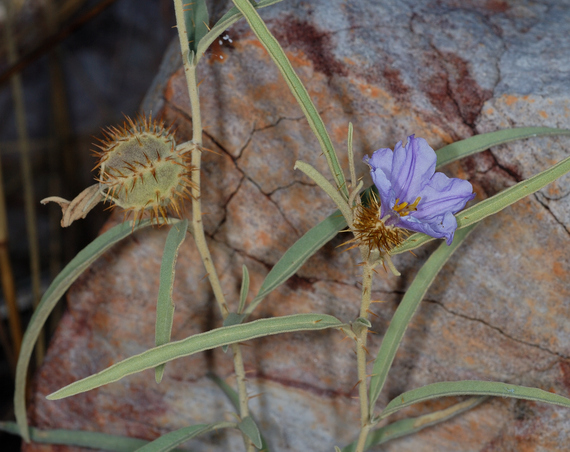A brand new cell part that flavors wine, a flower that depends on "footlong" moth tongues and a list of about 1,000 new species are the stories that topped my list of the most impressive things we learned about plants last year.
1. "Well, pour me a merlot and pound my baseball mitt..."
Imagine this happened a few months ago: A team of scientists discovers a new part inside of animal cells that not only requires a rewrite of every General Biology textbook, but affects the lives of many humans on a daily basis. You would have heard about such a thing, perhaps even on the evening news. It might be the sort of breakthrough that you'd expect to find on lists of the top scientific discoveries of 2013.
Well, this did happen last year -- except the new cellular organelle was found in the plant cell rather than in the animal cell. And very few people seemed to give a hoot.
But this was pretty big, folks. The discovery of a new cell organelle just doesn't happen very often -- and the one that was found, now called the tannosome, really does have some bearing on your life as a human being. We've been using and imbibing the plant products it is related to, called tannins, for as long as we have been us.
Tannins are the stuff we use to tan leather, so the preservation of your leather products depends on them: your shoes... your baseball mitt... your belts... even that leather jacket you wore in high school.
Tannins also have a lot to do with the flavor structure of wines, this being the main reason why the wine-loving community was one of the few groups of people outside of botanists who paid attention to this discovery when it happened.
We already knew that plants had tannins, of course. We just had no real idea how they got there. It turns out plant cells give that job to short-lived organelles ("mini-organs" that live inside cells; the nucleus, for example) that assemble, concentrate and transport the tannins within those cells. These tannosome organelles dump their tannins into a large storage space, the vacuole, where they can be released whenever a cell is busted apart -- like when an animal chomps on a leaf or a barefoot vintner stomps on some grapes.
Despite some work on the part of the plant science community to promote this finding, too many people missed or ignored the story. That's really too bad. To learn enough to really impress your wine-drinking friends at your next gathering, see here.
2. Size matters, especially in moth tongues and plant genetics.
Quick: Picture in your mind a plant growing in the desert.
Did you picture a cactus? Or did the plant at least have some of those cactus-like characteristics like sharp parts or fleshy water-storing leaves and stems? We associate extreme plant "behaviors" like these with living in the desert because it is really hard to make it there. Desert plants either find ways to deal with poor soils, high temperatures and little access to water, or they die.
In August, I accepted an invitation to catch up with the Chicago Botanic Garden's Dr. Krissa Skogen during her research trip to a northern portion of the Chihuahuan Desert in New Mexico's White Sands National Monument. What she showed me was, by far, the coolest thing I saw in 2013.
Krissa has spent the last several years tracking populations of an exceptionally pretty group of wildflowers called sundrops (known to science folks as Oenothera) across the western US. One of the things she noticed is that these plants occur in really small populations across fairly vast amounts of space, something that concerned her as a conservation biologist.
Small populations are always at risk for inbreeding; and inbreeding is the sort of thing that can push a wildflower species from uncommon to extinct. So Krissa did the genetics work to see what the DNA said. Were these populations at risk? Would she find, as one might predict, that populations of sundrops have limited gene pools due to their isolation?
The answer: Not like you might expect. The likely reason: Sundrops produce flowers with deep tubes full of high-octane nectar. And they only open at night -- in part because daytime desert temperatures are hard on flowers and tend to evaporate nectar, but also because that's when giant hawkmoths are most active.
In a beautiful example of coevolutionary adaptation, the long, hollow, straw-like tongues of the moths are perfectly suited for reaching and sipping up the nectar in the sundrops floral tubes.
The moths pick up a bit of pollen from every flower they visit, aiding the movement of sundrops genes. And the best news is that hawkmoths are long-distance flyers, sometimes covering as many as 20 miles of desert in a single night. That's enough distance to keep just about everybody's genes in the mix.
I thought this story was so great that we made a video about it. To learn more about Krissa's work, and to see us catching giant moths and collecting pollen from their tongues, check out Episode 4 of "Plants are Cool, Too!"
3. More proof that we haven't found everything.
I recently asked my non-majors botany class whether they thought, before they took my class, that science had discovered most of the species on Earth. Their perception, like I imagine it would be for many people, was that we had -- especially when it came to the obvious things like large animals and plants.
In looking at the numbers reported for 2013 by the International Plant Names Index (IPNI), I see that scientists published over 1000 new species names for plants last year. Clearly, as reported in this space previously, we are still far from finding everything.
With so many new plants discovered, the highlights are numerous -- and it would be hard to pick a favorite.
It could be the new meat-eating sundew discovered in Japan. Or a toss up between two things found in Vietnam: a new wild species of caper and a new flowering camellia. Or the new species of astragalus described from plants growing in ruins in southern Sicily. Or the new giant bromeliad so abundant in Brazilian treetops that populations are best viewed by airplane.
Botanists also found numerous other contenders: a new boxwood in Cuba, four new agaves in Arizona, a new campanula in Albania, two wild onions in turkey (plus another in Kyrgyzstan), three new dracontia orchids in Costa Rica, a new rhododendron in India, a new morning glory in California and more things from China and the Amazon than even the most driven gardener could find space for in their back forty.
But I'd be lying if I didn't admit that my favorite new species of 2013 is Solanum cowiei, the little Australian nightshade my colleagues and I described from Australia's Northern Territory -- where, unlike news of the tannosome, the discovery actually did make the evening news.
Plenty of other new things were learned about plants this year that aren't mentioned above, but are no less exciting or important. Notably, scientists sequenced the whole genome of Amborella, a species thought to be the closest living relative to the earliest flowering plants. And then other scientists found fossils from what just might have been one of those plants. To quote a friend's Facebook comment a few days ago, "There are still things to discover on this tiny space rock, after all."
Whether it's another new organelle, another novel melding of genetics and ecology, or a thousand more species, 2014 and every year going forward have the potential to generate new discoveries across all of science that both blow our minds and continue to help us uncover the mysteries of life on Earth.
There is plenty more to be found, so keep your eyes open... because there is always more room for people willing to join in the search.

